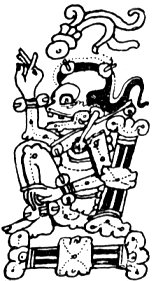Maya death rituals
[citation needed] People who died by suicide, sacrifice, complications of childbirth, perish in the ball game,[1] and in battle were thought to be transported directly into heaven.The reason a violent death led to one souls being able to immediately enter the Maya heaven is because the gods are thankful for their sacrifice to them.A pot from a Pacal tomb depicts ancestors of Maya kings sprouting through the earth like fruit trees and together creating an orchard.Due to its green color resembling that of corn stalks, burying the deceased with jade was believed to allow them to follow the path of the Maize God, eventually leading to their rebirth.Once a tomb was closed, burning took place on top of it to signify the soul leaving the royal body and transforming into an ancestral state.[4] Often, whistles carved from rocks into the shapes of gods or animals were included in the grave offerings to help the deceased find their way to Xibalba (She-BALba).To which then they would hold an all-night vigil around the corpse and burn incense calling on their ancestors to watch over the new soul in its journey in the underworld.Other burial practices included bodily humanation with structures, structures directly overhead of the burial site, preferred single interments over multiple interments, the removal of skulls with a bowl or shell over or under the skull, specific skeletal position, prevailing head orientations, jade mosaic masks, and shell figurines.In the Popol Vuh that the Kʼicheʼ Maya wrote, one of the few surviving codices, it tells the story of the reincarnation of the Maize god.In the tale, the maize god retreats to the underworld and with two hero twins battling the monsters and lords of the place, makes way back to the earthen world.Many have a generalized belief of all souls going to the afterlife, being reincarnated or having another role to participate in after death, but these ideas change dramatically with the rise of Christianity.[12] Qʼeqchiʼ bury their dead in a straw sleeping mat, with a hat, sandals and a net provided to help in the journey to the afterlife.The family members must perform a ritual to the deities to ask release of the souls of their dead relatives and to allow them entrance into the house.These aristocrats were placed in tombs at the bottoms of funerary pyramids that sometimes consisted of nine stepped platforms, perhaps symbolizing the nine layers of the underworld.The tombs were filled with precious goods including fine polychrome pottery, effigy figurines, jade and marble pieces, masks, mushroom figures.In the Tomb of the Red Queen inside Temple XIII in Palenque, the remains of a noble woman and all the objects inside the sarcophagus were completely covered with bright red vermilion dust, made of ground cinnabar, perhaps intended to suggest blood, the symbol of life.
Maya mythologyreligionItzamnaBloodlettingDedication ritualsPilgrimagePriesthoodSacrificeHumansCave sitesMiddleworldXibalbaDeities and beingsDeath godsJaguar godsAh PekuAh-Muzen-CabAwilixCabaguilCamazotzChirakan-IxmucaneEk ChuajGoddess IHero TwinsHowler monkey godsHuay ChivoHun HunahpuHuracanIxchelIxpiyacocK'awiilKinich AhauKukulkanMaize godMaximónMoon goddessNagualTzacolQ'uq'umatzVision SerpentVoltanVucub CaquixXbaquiyaloXmucane and XpiacocXmulzencabXtabayYopaatYum KaaxZipacnaAnnals of the CakchiquelsPopol VuhRitual of the BacabsTítulo C'oyoiTítulo de TotonicapánMaya religionritualisticsuicidechildbirthheavenSpanish influenceafterlifeMaya kingsfestivaltempleotherworldskeletalcinnabarcottonPreclassic periodClassic periodPostclassic periodcremationlunar eclipseDresden CodexKʼicheʼcodicesAwakatekoLakandonQʼeqchiʼTzʼutujilPoqomamMaya citypyramidsunderworldpotterymushroomObsidianTomb of the Red QueenPalenquevermilionBirmingham Museum of ArtMaya civilizationHistoryPreclassic MayaClassic Maya collapseSpanish conquestChiapasGuatemalaPeténYucatánArchitectureE-GroupTriadic pyramidTwin-pyramid complexRevivalGraffitiCeramicsCitiesCuisineEconomyMaritime tradeLanguagesClassicScriptMayanistMedicineMythologyNumeralsPeopleStelaeTextilesWarfareSocietyChildhoodMidwiferyHuman sacrifice